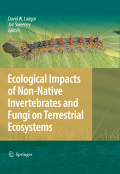
Ecological impacts of non-native invertebrates and fungi on terrestrial ecosystems
Langor, D.W.
Sweeney, J.
Since the arrival of Europeans about 500 years ago, an estimated 50,000 non-native species have been introduced to North America (including Hawaii). Non-native species figure prominently in our lives, often as ornamentals, sources offood or pests. Although many introduced species are beneficial, there is increasing awareness of the enormous economic costs associated with non-native pests. In contrast, the ecological impacts of non-native species have received much less public and scientific attention, despite the fact that invasion by exotic species ranks second to habitat destruction as a cause of species loss. Inparticular, there is little information about the ecological impacts of hyper-diverse groups such as terrestrial fungi and invertebrates. A science symposium, Ecological impacts of non-native invertebrates and fungi on terrestrial ecosystems, held in 2006, brought together scientists from the USA and Canada toreview the state of knowledge in this field of work. Additional reviews were solicited following the symposium. The resulting set of review/synthesis papers and case studies represents a cross-section of work on ecological impacts ofnon-native terrestrial invertebrates and fungi. State-of-the-art reviews Besttreatment of this topic available Addresses impacts of a range of exotic organisms in terrestrial ecosystems
- ISBN: 978-1-4020-9679-2
- Editorial: Springer
- Encuadernacion: Cartoné
- Páginas: 160
- Fecha Publicación: 01/02/2009
- Nº Volúmenes: 1
- Idioma: Inglés
